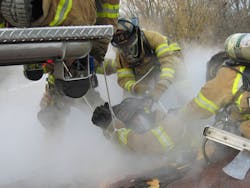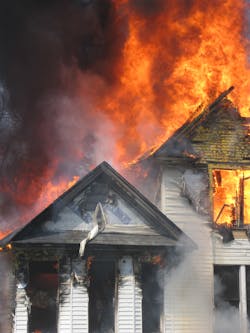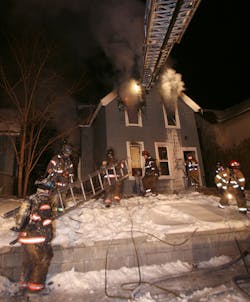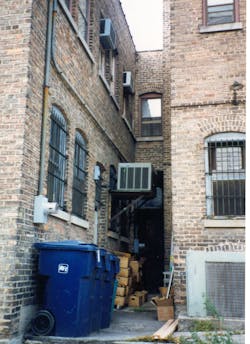Rapid intervention was the fire service “hot topic” in the 1990s through 2010. The Occupational Safety and Health Administration’s Respiratory Standard was revised to include the two-in, two-out rule.
The need to recognize rapid intervention was made reference to in NFPA 1710: Standard for the Organization and Deployment of Fire Suppression Operations, Emergency Medical Operations, and Special Operations to the Public by Career Fire Departments and NFPA 1720: Standard for the Organization and Deployment of Fire Suppression Operations, Emergency Medical Operations, and Special Operations to the Public by Volunteer Fire Departments. In 2009, NFPA 1407: Standard for Training Fire Service Rapid Intervention Crews, which outlines performance requirements, was developed. In addition, great importance was placed on training in the area of firefighter rescue.
Many thoughts, opinions and concepts of the best way to rescue one of our own have been brought forward, and much research has been conducted. Some of the research definitely points to changes that we need to consider when talking about training our members. Even though the majority of mayday situations that produce successful outcomes are mitigated by firefighters who send the mayday themselves, by their crew or by another member in the vicinity, there isn’t a valid reason why we still shouldn’t put an emphasis on this type of training. The rapid-intervention team (RIT) is the last hope that we have when immediate crews can’t affect the rescue or when the firefighter is unable to rescue him/herself. As a matter of fact, we should put even greater emphasis on it with the challenges that we face now.
The RIT intervention
In 2020, firefighters are provided with the most advanced tools and safety equipment that ever have been provided to the fire service, yet we still continue to have firefighters die in the line of duty.
Although a good thing, the fact that we are responding to fewer and fewer actual working incidents each year also is disturbing. The ability for our new leaders and up-and-coming officers to gain valuable experience has been diminished. (Past experience allows us to predict outcomes and to make sound, split-second decisions that are necessary on the fireground.)
The pace of our fireground as well as the window for success has changed dramatically over the past 30 years due to building construction and the materials that make up the fireground environment. Unfortunately, training and tactics that are employed on the fireground haven’t changed at the same pace, and lessons still haven’t been learned from the sacrifices of others.
Most disturbing is how it still holds true that a breakdown in basic core skills continues to be a prominent factor in firefighter line-of-duty deaths and injuries that are sustained on the fireground.
The five most common factors that were cited in the National Institute of Occupational Safety and Health’s firefighter fatality reports 25 years ago still are valid today:
- Breakdowns in the incident management system;
- Lack of or inadequate standard operating procedures (SOPs);
- A breakdown in the accountability of personnel on the fireground;
- Breakdowns in communications on the fireground; and
- Lack of recognition of key aspects that are related to fire behavior and building construction.
All five of these factors are things that we can control before we even hit the street to respond to an alarm.
To be successful and to function on the fireground when it comes to rapid intervention, as well as to combat the five mentioned factors, a fire department should be covering 18 basic points.
1. A plan
Does your department have an actual policy or operating guideline in place when it comes to rapid intervention? A plan that all members have been trained on for calling a mayday on the fireground as well as a plan for rapid-intervention operations?Even more important, does every member understand that policy?
No matter what method is used, the important point is that your department has a procedure, and everyone, from the chief to the greenest rookie, understands the process. Even more important, however, is that every member is trained to recognize when he/she is in trouble and to call for help at the earliest point to provide the best chance of survival.
2. Rescue equipment
Does your department have the resources in place to staff a RIT on the fireground? In other words, does your department have the proper rescue equipment to fulfill rapid-intervention responsibilities on scene, so it doesn’t have to call for it after a mayday is declared? Is the function an automatic predesignated assignment?
Remember, when a RIT is placed into action, the resources better be in place to back up that RIT. It has been common practice that many departments will escalate the alarm by two levels when a RIT is activated. No department, with the exception of those that serve the largest cities, has the capability to properly fill this role by itself.
Break down the fences and get your neighboring departments to help, and get that help rolling early in the response. It always can be returned if not needed.
3. Command presence
If a mayday is called, a plan to provide strong command presence in the rescue efforts, while maintaining discipline and control of fire-suppression measures, is a must.
Managing a mayday requires the incident commander (IC) to get help, but it’s ever so important that discipline is maintained. The suppression efforts must continue, and they must be managed, but, now, a RIT is deploying into a hazardous condition, and they must be closely managed and have strong command presence to maintain their safety.
4. Risk assessment
Department members must understand their role and be able to practice continual ongoing risk assessment when functioning as a RIT on the fireground. The RIT functions as an additional set of eyes for the safety officer and IC.Risk-benefit analysis is something that must take place every time that we commit people to immediately dangerous to life and health (IDLH) conditions. It lays the foundation for every decision that we make at an incident and must be reevaluated constantly throughout the duration. Taking the time to fully realize what we are dealing with on the fireground is critical.
5. Proactivity
The RIT needs to work proactively on the fireground. However, they need to make certain that they’re ready to respond at any moment to a member who is calling for help. One of their main functions is to “soften” the fireground.
6. RIT skills
Firefighters who fill the rapid-intervention function on the fireground must be properly trained. Solid RIT skills come from thorough knowledge and understanding of the basics of firefighting. Proficiency in the areas of PPE, SCBA, fire behavior, building construction, ropes and knots, ladders, tools and equipment, forcible entry and communications provide the foundation to build RIT skills. If your people don’t possess proficiency in these areas, how can you expect them to perform advanced skills, such as the rescue of a downed firefighter?
Once firefighters have a solid background in the basics, they need to be trained in self-survival skills before progressing into the rescue of one of our own. This provides an understanding of what firefighters who are being rescued will be trying to do to save themselves prior to the RIT getting to them. It also serves as a basis of what can be expected to be encountered. Some skills that should be included in this area are window hangs, wall breaching, drywall ladder establishment and emergency egress techniques, such as ladder bails and rope slides.
7. SCBA limitations
Every firefighter needs to know and understand, inside and out, SCBA, including their limitations. Fire department members need to be skilled in using the SCBA to its fullest potential but also know the principles of air management.
Techniques that are needed to troubleshoot and correct low order failures in hostile conditions are a necessity, as are techniques that might be necessary to navigate through life-threatening situations.
A firefighter’s working air supply will depend on the firefighter’s physiology and on the firefighter’s physical condition, activity and mental state that’s experienced under the stressful conditions that are encountered during firefighting—not to mention his/her application of what was learned during training.
Does your department complete air-consumption drills for each firefighter on an annual basis? NFPA 1984: Standard on Respirators for Wildland Fire Fighting Operations specifically mandates the drills to be completed each year.
8. Understanding TIC
All members of your fire department must understand the uses and limitations of thermal-imaging technology on the fireground. If not, you can be asking for serious trouble.
The use of thermal-imaging cameras (TICs) can result in firefighters developing an overconfidence and a reliance on the use of the camera. The use of thermal imaging can’t replace a secure and basic foundation in search techniques, but it can be invaluable when used correctly by a properly trained firefighter.
9. VES and RASP
Does your department train and practice search techniques on a regular basis? When was the last time that crews actually deployed rope and performed a team search? Members of your department should train on basic and advanced search procedures, including Vent Enter Search (VES) and rope-assisted search procedures (RASP).
Preparation for performing fireground searches must be mental as well as physical. Basic skills, such as orientation drills and mental mapping, need to be conducted on a regular basis.
Large area searches present challenges and dangers that are out of the ordinary for firefighters. Are they familiar with these, and do they fully understand the method or techniques that are practiced by your department for these types of operations?
10. Air supply
Members of your fire department should be skilled in and have practice getting an air supply to a member who is out of air or trapped. Getting air to the downed firefighter has to be your first priority after finding him/her.
Are all of your department’s SCBA units up to date with the presence of universal air couplings, and do the members of your department understand how to work each and every option for getting air that’s present on your rapid-intervention pack?
11. Specialized equipment
Are your department members skilled in operating specialized rescue equipment, and have they practiced using it under hostile conditions?
The RIT isn’t a technical rescue team, but they will have a duty to attempt the initial rescue efforts of trapped firefighters. However, the RIT’s capabilities will be limited by the members’ training and the equipment that’s available.
Firefighters drill periodically with specialized tools and equipment in conditions that allow them to concentrate on and visually see what they’re doing. Can these members operate tools, such as shores and air bags, in hostile conditions that might be encountered in a situation that involves a trapped firefighter?
12. Moving firefighters
Many of the difficulties that are experienced in moving a downed firefighter result from the gear that they wear. Therefore, department members should be practiced and skilled at moving firefighters over and around obstacles, including stairs.
Limited “grab points,” bulkiness and entanglement points are just a few of the difficulties that might be encountered. Moving a downed firefighter is a whole different game than trying to move a civilian. Firefighters won’t know how to mitigate these issues unless they train on overcoming them.
13. Enlarging openings
Members of your department should train on and become proficient at enlarging existing openings in structures as well as forcible-entry techniques.
When talking about rapid intervention, it’s important to keep an open mind and to think outside of the box to a degree.
Conventional methods of removal might not be the quickest or easiest in all circumstances. Enlarging openings can create an entry or egress point to retrieve a downed firefighter. Making windows into doors is a very simple procedure on wood-frame structures and can be accomplished in less than 30 seconds with three cuts, as long as firefighters are familiar with the technique and are skilled in the use of basic tools. Enlarging openings can equate to forcible entry, in the form of removal of objects, such as doors, burglar bars, plywood that covers windows and anything else that impedes the egress of firefighters.14. Constricted spaces
Firefighters should be trained on how to remove trapped firefighters from constricted spaces as well as out of windows. So, can your department members successfully get a downed firefighter up and over a windowsill to facilitate his/her removal? Numerous techniques have been developed to accomplish this, even in extreme circumstances. (When Denver firefighter Mark Langvardt was trapped, rescuers encountered a 22-inch window that was 42 inches off of the floor, and they had only 28 inches width of space to work within.)
If we train and can function under those types of circumstances, we can apply the same principles or methods to be successful when all of those extreme conditions aren’t present.
15. Upper levels
Once out of the window, we must be proficient on getting the firefighter down to the ground level. The place to figure out what way is best isn’t on the fireground, where seconds count. That’s why firefighters need to be proficient at removing downed firefighters from upper levels using ladders and aerial devices. This is a firefighting basic and, really, is no different than the skills for removing civilians.
Are all department members of proficient in operating the aerial device that might be present on your fireground? This might seem extreme, but what happens if a mayday occurs and that device is needed, but the driver/operator isn’t available?
16. Below grade
Are members of your department skilled at various techniques to remove a firefighter from a sublevel or below-grade rescue situation? Many alternative techniques have been introduced and perfected to rescue a firefighter in a floor-collapse situation. Different techniques should be trained on consistently to find out which ones work better or are more comfortable for the people who perform them. The time to learn isn’t during a mayday situation.
17. The anchor
Techniques that are kept simple can be very useful for RIT or survival operations. One of the most crucial steps that’s involved when using rope for rapid intervention is the establishment of an adequate anchor. If one isn’t readily available, the firefighter must understand how to fabricate one. Members of your fire department should have the knowledge and skills to create anchor points and simple mechanical-advantage systems.
Basic mechanical-advantage systems are incorporated into rapid intervention for the purposes of dragging, lifting or raising downed firefighters. They are meant to decrease the weight of a downed firefighter and to make the task more efficient for rescuers. They aren’t meant to be set up in the same manner as high-angle or vertical rescues, which require additional expertise and equipment. The rescue of a downed firefighter isn’t meant to be a technical-rescue incident. Time is of the essence; things must be kept simple and safe.
The concepts of mechanical advantage actually are quite simple and easy to use. In fact, most RIT techniques are easy and quick to perform with a proper prerigged, 2-to-1 mechanical-advantage system—even in a dark, smoke-filled environment.
18. Lowering
Operating above the fire, such as on the roof, can be very high risk. Not only can firefighters fall into attic spaces due to construction failure, but a RIT also can be faced with firefighters who become disabled because of medical problems.
What techniques are your people familiar with to accomplish a removal such as this when an aerial device isn’t available or able to be used? Firefighters must know how to lower downed firefighters from upper levels using basic equipment.
Honor the fallen
Training is the key to successful RIT operations and to staying out of trouble on the fireground. Knowing the basics that are needed for RIT operations can mean the difference between life and death. There are many variations of the basics that work also. The important things are to train on them safely and to know them well.
The 18 points that were discussed here to evaluate your department’s RIT capabilities all can be referenced to actual incidents that resulted in a line-of-duty death. Don’t ever forget the sacrifices that were made by those firefighters. Honor them every time that you respond to an alarm by applying lessons that they provided to us.
We must challenge the traditions and attitudes that lead us to failure. Today, we operate in a very volatile environment, both on and off of the fireground. Are we ready for these challenges, and do our members have the skills to overcome them?
About the Author
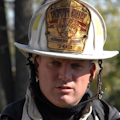
Jeffrey Pindelski
JEFFREY PINDELSKI is the Downers Grove, IL, Fire Department Chief (Ret.) and has been a student of the fire service for more than 30 years. He served as a chief officer for more than 15 years of his career, during which time he directly managed every aspect of the fire department at one time or another. Pindelski holds a master's degree in Public Safety Administration from Lewis University and earned a Graduate Certificate in Managerial Leadership and a bachelor's degree from Western Illinois University. He is the co-author of "R.I.C.O.- Rapid Intervention Company Operations" and was a revising author of the third edition of "Firefighter's Handbook." Pindelski presented at numerous fire service conferences and had more than 55 articles published in trade journals on various fire service-related topics. He is a recipient of Illinois' Firefighting Medal of Valor.
